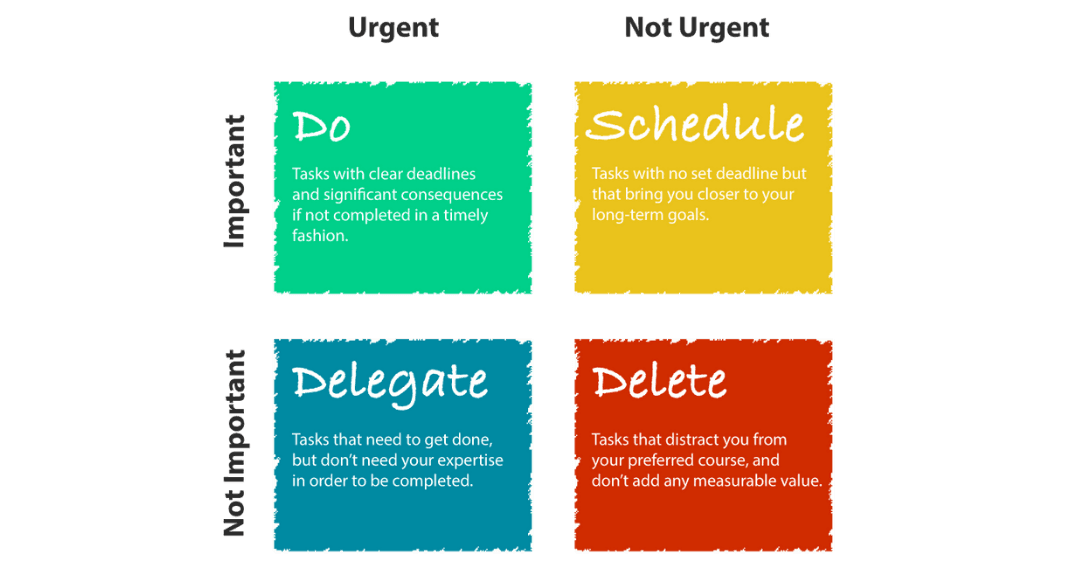

Time Management Advice That Helps You Get Things Done and Breathe

13 May, 2025
Share this article
Table of Contents
They say time flies when you’re having fun. But let’s be honest, it also flies when you’re replying to emails, sitting in meetings that should’ve been messages, or staring at your screen trying to remember what you opened it for.
Time management isn’t about squeezing more into your day. It’s about being more intentional with the time you already have. If you’ve ever finished a long day feeling like you were busy but got nothing done, you’re not alone.
Most of us are juggling more than we’d like to admit, and it’s easy to feel like there’s never enough time for everything.
The good news is this: time management is a skill. Not a talent, not a superpower, just something you can get better at with the right tools and a little consistency.
When you learn how to manage your time well, things start to shift. You feel more in control. You get the important stuff done. You even find pockets of time to rest without guilt.
In this guide, you’ll find time management tips that actually work. We’ll talk about how to prioritize, how to plan your day in blocks and set time limits, how to stay focused, and how to stop wasting time without even realizing it.
You’ll learn how to set goals that make sense, use tools that fit your style, and balance everything on your plate without burning out. Nothing fancy, just smart, simple ways to make your time work better for you.

Begin with calm. Make space for what matters most.
Understand the Basics of Time Management
Time management is one of those things we all talk about, but not many of us feel we’ve really figured out. It can sound complicated, like something reserved for ultra-productive people with color-coded calendars and zero distractions. But the truth is simpler than that.
Time management is just a way of being more intentional with how you spend your time. That’s it. And once you start doing that, even in small ways, your days begin to feel a lot more manageable.
It’s not about squeezing more into your schedule. It’s about making space for what matters. A well-managed day includes time to focus, time to rest, and room to breathe. The goal isn’t to be busy from morning to night. The goal is to spend your time in a way that feels right.
That starts with knowing what deserves your attention. Some things feel urgent but aren’t really important. Others are easy to put off even though they matter most. The better you get at telling the difference, the more your time works for you.
Clear goals come next. They help you move with purpose and say no to the things that don’t fit. And when you give your full attention to one thing at a time, your work improves and your mind calms down.
Here’s the short version:
- Prioritize what matters. Focus on the tasks that move things forward
- Set clear goals. Know where you’re going and why
- Stay focused. Do one thing at a time and do it well
- Be intentional. Make choices instead of running on autopilot
You don’t need to do it perfectly. You just need to start noticing where your time goes — and start choosing where you want it to go instead.

Clarity starts with one step in the right direction.
Prioritize Tasks: Focus on What’s Important and Urgent
When your to-do list is overflowing, it’s tempting to jump into the first thing that catches your eye. Maybe it looks quick. Maybe it feels urgent. But just because something demands your attention doesn’t mean it deserves it. That’s why learning to prioritize is so important.
A simple tool that helps is the Eisenhower Matrix. It asks two questions: Is this important? Is it urgent? Based on your answers, tasks fall into four categories. The ones that are both important and urgent should be done now.
The ones that are important but not urgent should be scheduled. Urgent but not important? Try to delegate or minimize them. And the ones that are neither urgent nor important can usually be let go.

If you’re not sure what to focus on, look for what moves the needle. What will make a difference in the long run? What’s worth your energy today, even if it’s quiet work no one sees? Those are your high-impact tasks.
And yes, low-priority work will always be there, trying to sneak into your day. The key is knowing when to say no. It doesn’t have to be dramatic. A simple pause or a polite delay can protect your time.
A few things to keep in mind:
- Use the Eisenhower Matrix to separate noise from what matters
- Look for high-impact tasks that actually move things forward
- Say no when needed to protect your time and focus
- Make decisions with intention, not just pressure or habit
Prioritizing gets easier with practice. And once you stop reacting to everything that feels urgent, you can start choosing what really deserves your attention. That’s when your time starts working for you.

Focus on the peak, not the noise below.
Use Time Blocking to Structure Your Day
If your day keeps slipping away and you’re left wondering what you actually got done, time blocking might be the structure you need. It’s a simple method that can change the way your day flows.
Instead of working from a never-ending to-do list, you assign blocks of time to specific tasks. One block for deep work, one for emails, one for meetings. Each task gets a place on your calendar.
This isn’t about planning every minute. It’s about giving your priorities a clear home. For example, you might block 9 to 11 for focused work, 11 to 12 for meetings, 1 to 2 for admin, and 3 to 5 for projects. Even if things shift during the day, you always have a structure to return to. That alone can lower the mental clutter.
Time blocking also helps you stay focused. When you know exactly what you’re supposed to be working on, there’s less room for multitasking or mindless scrolling.
And it gives you a natural stopping point. When the block ends, you move on, instead of getting stuck trying to perfect something that just needs to be done.
Here are a few ways to make it work:
- Block time for your priorities so the most important tasks always have a place
- Group similar tasks to stay in the same mental mode and avoid constant switching
- Stick to the schedule as much as possible, but give yourself space to adjust
- Protect your deep work blocks by turning off distractions and treating them like appointments
You don’t need to plan your day down to the minute. Just be clear about what matters and give it the time it deserves. That small shift brings more focus, less stress, and a day that feels like it’s actually yours.

Work in stillness. Pause. Then return with focus.
Stay Focused with the Pomodoro Method
If your mind tends to wander or you catch yourself checking your phone every ten minutes, the Pomodoro Method might be just what you need. It’s a simple approach built on short, focused work sessions with regular breaks. Nothing fancy, but surprisingly effective.
Here’s how it works. You set a timer for 25 minutes and focus on one task only. No switching tabs. No checking notifications. When the timer rings, you take a five-minute break.
After four sessions, you take a longer break of 15 to 30 minutes. These short bursts keep your brain engaged without pushing it to the point of burnout.
The Pomodoro Method is especially helpful when you’re avoiding a task or when your energy is low. Knowing you only need to focus for a short time makes it easier to get started. And because the blocks are tight, you’re less tempted to multitask.
It also teaches you to set boundaries. Instead of working until you’re drained, you work in cycles that protect your attention and help you stay fresh longer.
Here’s how to give it a try:
- Work in 25-minute sprints and focus on one task at a time
- Take five-minute breaks to reset your energy
- Track your Pomodoros so you can plan better in the future
- Use it when motivation is low or tasks feel overwhelming
You don’t need any special tools. Just a timer and a bit of focus. The Pomodoro Method helps you protect your attention and make steady progress without exhausting yourself.

Progress is steady, not rushed.
Set Realistic Goals and Deadlines
Big goals are exciting. They give you something to reach for and a reason to push forward. But if those goals are vague or too ambitious from the start, they can turn into pressure instead of motivation. The key is to make your goals clear and doable, not just impressive on paper.
That’s where the SMART method comes in. A good goal is specific, measurable, achievable, relevant, and time-bound. In other words, you know exactly what you’re working toward, why it matters, and when it needs to happen.
That kind of clarity makes it easier to stay focused and make real progress.
Big projects can feel overwhelming, especially at the beginning. That’s why breaking them down helps. If you need to launch a new website, start with one piece at a time. Write the content. Choose the layout. Upload the images. Test the final version. Every step you complete builds momentum for the next.
Deadlines matter too. A task with no clear deadline often gets pushed aside. When you give something a date, it becomes real. And if you share that deadline with someone else, you’re more likely to stick to it.
To make your goals more effective:
- Use SMART goals to stay clear and realistic
- Break big tasks into small steps that feel manageable
- Set deadlines to create urgency and follow through
- Track your progress and celebrate what you complete along the way
You don’t need perfect goals. You just need goals that help you move forward without losing steam. When your plans are clear and grounded, it’s easier to focus, stay motivated, and actually finish what you start.

Follow the path. Let clarity rise with each step.
Identify and Eliminate Common Time-Wasters
You sit down to work, full of good intentions, and two hours later you’ve answered a few emails, checked your phone more times than you can count, googled something random, and barely touched the task you meant to finish. Sound familiar? Time-wasters are quiet, sneaky, and incredibly good at stealing your day.
Most of them are habits we don’t even question. Checking social media. Reacting to every notification. Jumping between tasks to feel busy. Multitasking might look productive, but it actually slows you down and scatters your focus. And email? You don’t have to answer everything the moment it lands. That sense of urgency is rarely real.
The first step is simply noticing. Pay attention to what pulls you away from what you want to do. Once you see the patterns, you can shift them. Turn off alerts during focused work. Set specific times for checking email. Use website blockers if certain sites always distract you.
Digital tools can help too. Apps like Freedom, Focus Keeper, or Screen Time show where your hours go and help you stay intentional. Sometimes, just seeing the data is enough to reset your habits.
To cut down on time-wasters:
- Notice your patterns and catch distractions before they take over
- Cut the noise by turning off alerts and creating a calm workspace
- Avoid multitasking and focus on one task at a time
- Use digital tools to track your usage and stay aware of where your time goes
You don’t have to remove every distraction. Just the ones that give you nothing in return. When you clear out the noise, you make space for work that matters — and you get it done with a lot less stress.

Let calm follow the chaos. Stay with it.
Use Time Management Tools and Apps
You don’t have to manage your time with just a notebook and good intentions. There are plenty of digital tools that can make your day feel less chaotic and a lot more organized. The key is to choose the ones that actually match how you work, not just what sounds good in theory.
If you’re handling multiple projects, tools like Asana or Clickup can keep everything in one place. You can track deadlines, assign tasks, and break big projects into smaller steps that feel doable.
For planning your schedule, Google Calendar is simple but powerful. You can block time, set reminders, and avoid that scrambled feeling of forgetting something important.
If staying focused is a struggle, apps like Forest or Focus Keeper can help. Forest lets you grow a little tree while you work, which sounds silly until you realize how motivating it is to stay on task. These tools use short focus sessions and regular breaks to keep your brain engaged without burning out.
Some tools also help by doing the boring stuff for you. Use recurring tasks, email filters, or calendar integrations to skip the setup and get straight to the work. The less energy you waste on routine tasks, the more you can focus on what matters.
A few ideas to start with:
- Use project tools like Asana or Clickup to manage big-picture work
- Plan your time with Google Calendar and block out your day
- Stay focused with apps like Forest or Focus Keeper
- Automate what you can to save energy and avoid repetitive tasks
You don’t need a whole folder of apps. Just a few well-chosen tools can make a real difference in how clearly and calmly you move through your day.

Strong foundations carry more with less effort.
Balance Multiple Projects and Responsibilities
When your to-do list stretches across teams, deadlines, and competing priorities, it’s easy to feel scattered. You’re pulled in different directions, and no matter how much you work, something always feels left behind.
But managing multiple projects isn’t about squeezing in more hours. It’s about being clear with your time, energy, and focus.
Start by planning your week before it begins. Take ten minutes to look ahead. What’s coming up? What really needs your attention? Block time for deep work and give yourself some breathing room. A plan helps you move with intention, not guesswork.
Try batching similar tasks together. Writing, admin work, calls — group them so you’re not constantly switching gears. Your brain works better when it can stay in the same zone for a while. Fewer shifts mean less friction and more progress.
If you’re working with a team, delegate when you can. You don’t have to do it all. Handing off even a small part of a project frees up space for what needs your full attention.
Keep a master task list. Doesn’t matter where, just make sure it’s all in one place. Review it often. It’s easier to stay organized when you can see everything clearly.
And know your limits. Constantly pushing through leads to burnout, not results. Protect your time. Make space to reset.
To stay balanced:
- Plan your week with the big picture in mind
- Batch tasks so you stay in flow
- Delegate when possible to stay focused on high-value work
- Keep one master list so nothing gets lost
- Respect your limits and build in time to rest
You don’t have to carry it all at once. With a bit of structure and intention, it’s possible to keep everything moving without running yourself into the ground.

Make time work for life, not just work.
The Benefits of Effective Time Management
When you manage your time well, your days feel more grounded. You are not just reacting to whatever pops up. You are choosing how to spend your time. That shift brings more structure, less stress, and a better rhythm to both your work and your life.
Here is what effective time management can give you:
- More productivity and focus. You get things done faster because you are working with purpose, not on autopilot
- Extra free time. When your tasks are planned and realistic, there is room left for rest, creativity, or just being with the people who matter
- Less stress. A plan brings calm. You stop chasing your day and start leading it
- Better mental health. With balance in place, you avoid burnout and stay steady, even when things get busy
Time management is not only about being efficient. It is about being intentional with your time so you have space for the things that make life feel full. It is a skill worth building, not just for work but for everything that happens outside of it too.

Conclusion
Time management comes down to a few simple habits. Prioritize what matters. Set clear goals. Block your time. Stay focused. Cut the distractions. Use tools that match your style and do not be afraid to say no when you need to.
Everyone works a little differently, so take time to experiment. Find a rhythm that feels natural and supports the way your brain works. You will not get it right every day. Unless you are a robot. And even then, good luck with the Wi-Fi.
The goal is not perfection. It is progress. When you start using your time with intention, you feel more in control, less stressed, and better prepared for whatever the day brings.
Remote work
Keep up to date with our most recent articles, events and all that Pluria has to offer you.
By subscribing to the newsletter you agree with the privacy policy.

In the last two years I’ve been working remotely from over 20 countries but no part of the world compares to Latin America: countries and cultures spreading over two continents with climates[...]
04 December, 2023

A massive move to hybrid work
In 2022, 60% of companies will switch to a hybrid working model, and a third of them will fail on their first attempt to work from anywhere, Forrester p[...]
04 December, 2023

When the employees in the most innovative company on the planet rally against their CEO because he wants them back in the office three days a week, it is a sign that it is not enough to be innovative in tec[...]
04 December, 2023